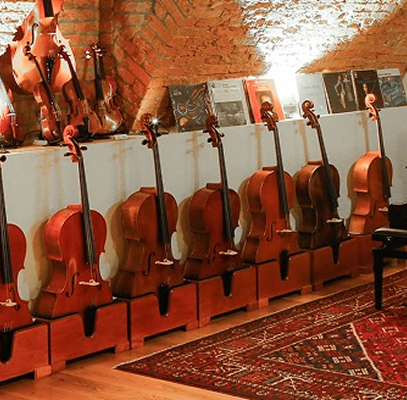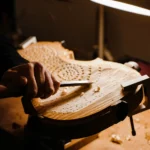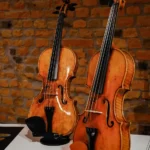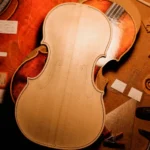Choosing the Right Violin Bow
Back to BlogA Beginner’s Guide to Choosing the Right Violin Bow
To a violinist, a bow is more than simply a tool — it is an extension of their fingers and the sound they produce. A good bow should make your notes sing, your dynamics flow, and the whole experience seem easy.
This newcomer’s guide will take you through what to look for in a violin bow and how the wood, weight, balance, and other factors matter when testing and maintaining a bow that matches your individual playing style.
Understanding the Violin Bow
Anatomy of a Bow
A violin bow has four main components: the stick, frog, hair, and tip. Each part has a role to play in tone, control, and playability. The stick gives you support and allows flexibility, whereas the frog gives you a place to attach the hair and adjust tension.
Bow hair, usually made of horsehair, grips the strings to produce sound, and the tip keeps the bow at good tension and balance.
Function And Role
The violin bow transforms motions into musical expression. The bow does not merely move across the string; the role of the bow allows for shaping dynamics, articulation, and resonance.
Proper bowing technique means that the musician can control volume, tone color, and phrasing. Awareness of how the bow acts with the violin provides a starting point for technical development as well as expressive playing for beginners.
Factors to Consider When Choosing a Violin Bow
Balance and Weight
A violin bow’s weight and balance affect comfort and control significantly. Heavier bows can produce a fuller, richer sound, but they can also tire the player sooner. Lighter bows will produce agile, quick, and easy bowing, which is excellent for delicate passages.
A properly balanced bow allows natural movement of the bow while also allowing the player to apply even pressure on the strings. Beginners should try several bows until they find one that is comfortable and feels easy in the hand, so they will be able to produce a good tone without strain even during their long practice sessions.
Material and Flexibility
The material of a bow affects the tone, durability, and responsiveness. Pernambuco sticks are sought for their warmth, flexibility, and range of tonal color.
On the other hand, flexibility is how a bow can rebound after the stroke and how it responds to articulation. When you find a bow that matches your playing style, it will help you shape your phrasing, dynamics, and best support your projection.
Size and Length
The size of the violin bow is important to consider for proper hand comfort and technique. While a standard full-size bow will usually fit adult players, an adult may want to try a bow size a little shorter.
The length of the bow will affect leverage, balance, and ease of control. You should try out different lengths of bows to see which one works well with your violin to allow proper movement, posture, and release of tonal quality.
Types of Violin Bows
Bows for Beginners
If you are a beginner player, then you would want a violin bow that is cost-effective, durable, and forgiving. Typically, beginners chase a less expensive pernambuco violin bow.
These bows allow the new player to develop consistent technique and a reasonable tone. When you choose a beginner bow, you provide yourself with comfort and confidence that will help wrap up frustration and facilitate further growth.
Intermediate and Advanced Bows
Both intermediate and advanced players benefit from bows that add richness of tone and articulation. A good quality violin bow at this stage is created from the finest pernambuco and offers enhanced responsiveness
These bows offer complex control for dynamics, phrasing, and projection, allowing the player to discover expressive dimensions. A bow of professional quality can lift technical mastery into artistry.
Testing and Selecting the Right Bow
Trial Techniques
When testing a violin bow, try using different bowing techniques: spiccato, legato, and additional dynamics. This will give you an idea of how the bow handles articulation and pressure.
In any case, testing different strokes will help beginners feel how smoothly the bow glides across the strings and if the bow supports a consistent sound production, which can be helpful for identifying possible choices.
Listening and Feel
It is important to assess tone, balance, and response when selecting a violin bow. Therefore, please be conscious of how equally the softest pitches resonate for you, as well as how easily it is for you to control the weight of the bow.
A bow should feel natural in your hand and produce a clear and expressive tone, thus allowing for the most comfort and musicality. A personal preference plays a large part in this process.
Making a Shortlist
When you have finished testing, narrow your options down to the final 2-3 bows that meet your style of playing. The violin bow should match your technique, hand size, and goals.
Take notes on your impressions, compare the pros and cons of your top choices, and if needed, test them again before deciding. By taking this approach, you will be confident with the final decision.
Care for Your Violin Bow
Daily Maintenance — Every time you play, make sure to wipe your violin bow so you do not build up rosin dust or sweat on the bow, and you keep the stick clean for a smooth performance.
Proper Bow Hair Maintenance — You need to clean the bow hair occasionally to make sure dirt does not get on the hair. You should apply rosin sparingly so it remains even for gripping and for producing the best sound.
Storing the Bow — Make sure you store your bow in a case that is protected from humidity so the stick does not warp or crack.
Climate Control— Avoid storing your violin bow in extremes of temperature or dry heat. You can keep your violin bow somewhat damp with a humidifier, and always have a humidifier on in your home.
Rehairing the Bow — Your bow should typically be rehaired every 6–12 months, depending on use. For professionals this time frame is usually shorter. Rehairs should be scheduled so your bow plays consistently every time you pick it up.
Conclusion — Bowing to Excellence
Finding the right violin bow will help you to improve your playing, comfort, and musical expression. Thus, allowing your technique and artistry to flourish. Explore Amorim’s curated collection to find a violin bow crafted for both beginners and experienced players seeking musical excellence.









